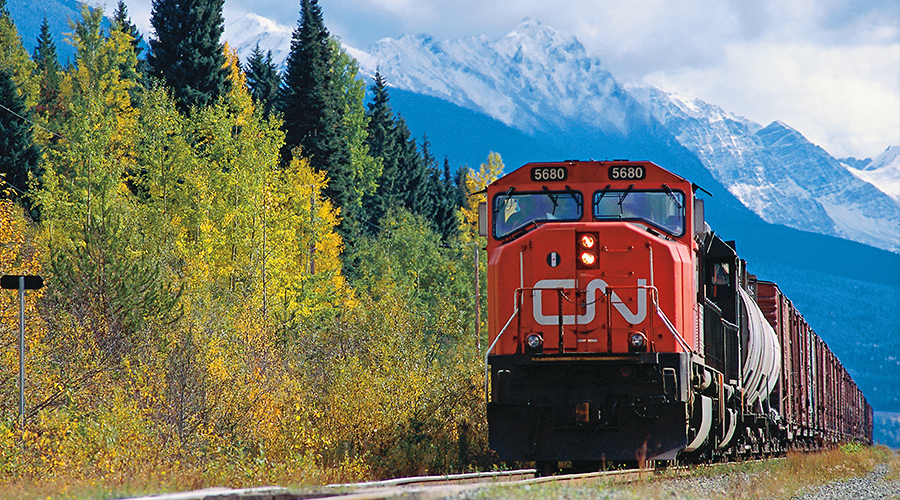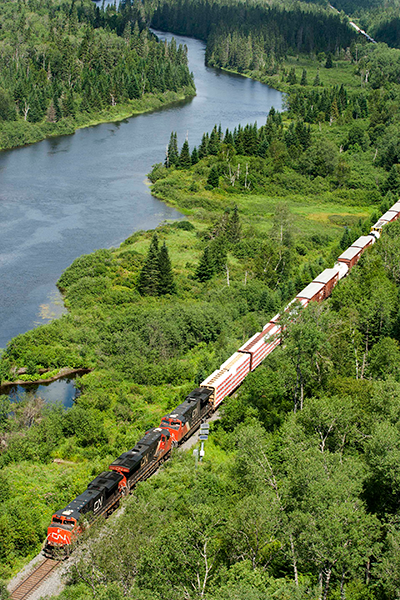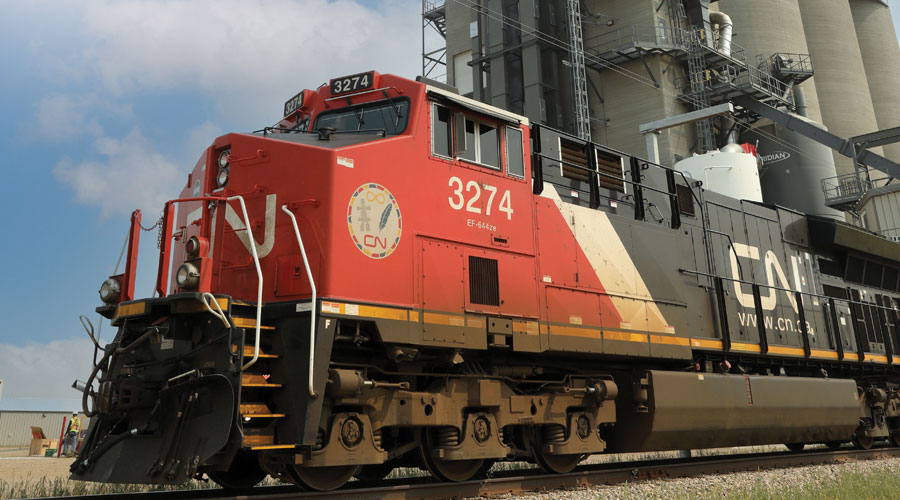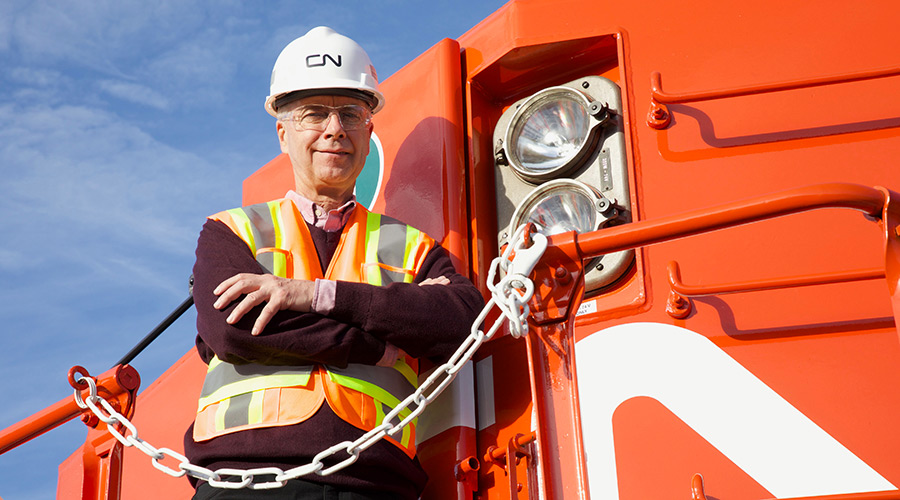Stay updated on news, articles and information for the rail industry
October 2023
Rail News: Canadian National Railway - CN
CN's marching orders to the tune of a new operating model seem simple, but perfecting the steps isn't

By Jeff Stagl, Managing Editor
A little more than a year ago, CN was struggling with operational performance. Despite employing what was believed at the time to be a solid scheduled railroading plan, unexpected events or marketplace changes tended to disrupt operations.
Severe weather, a supply-chain shift or a sudden demand swing sometimes caused some service metrics to erode.
But now, operations are much more fluid and consistent. So far in 2023, CN is performing better in every service metric even though the Class I has encountered a cold and snowy winter, excessive summer heat, wildfires, a West Coast port strike in Canada and a soft North American economy.
Why? Because CN continues to carry out the following operational marching orders with a revamped and revitalized scheduled railroading model: Make the plan, run the plan and sell the plan. Those orders seem simple — and generally describe how any railroad carries out an operating plan — but the thinking behind them, the ongoing execution and the efforts to perfect the steps ahead are anything but.
During presentations at an investor day event held May 3 in Chicago and in interviews with Progressive Railroading in late August, several CN senior executives described why the new operating model needed to be developed, what the Class I hopes to derive from it and how the new plan already is proving to be the right choice for the railroad’s network under all circumstances.
The central theme: Run a more tightly scheduled operation so the railroad can move assets quickly and efficiently, serve customers more consistently and drive business growth initiatives.
The new model has shifted the railroad away from a long-train strategy that had been in place for several years and back toward a disciplined scheduled railroading operation. That’s been no easy task given the workforce and network needed some retooling or retraining for scheduled railroading, which CN began using in the 1990s.

Tailored to three regions
Scheduling, resources and asset optimization are highly considered when developing a plan. It needs to incorporate the characteristics of CN’s bulk traffic-heavy western region, consumer goods-centric eastern region and manifest traffic-dominant southern region.
The service design team is responsible for developing the plan and monitoring its effectiveness in conjunction with the transportation, intermodal, sales and marketing, human resources and other departments. One main goal is to avoid operating trains that are too long to fit on sidings so key routes don’t get blocked by long trains.
The team is responsible for creating a plan that ensures the right rail car is on the right block on the right train, and that all trains are operated on time with disciplined motive power and crew usage. Cars need to move as long a distance as possible into the network without any stops, handling events need to be minimized, and first- and last-mile service needs to be optimized.
“The way this model works on our railroad is that the plan is created at the center. [It] looks at all the volume across the network and all the parameters,” said CN President and CEO Tracy Robinson during investor day.
Then, a plan is crafted that can optimize the entire network instead of meeting the operating needs of individual yards and facilities. And the plan is the plan — there is no backup or alternative.
“The plan is sacred,” said Robinson. “We’re not going to change how we operate the network in the face of weather and volume challenges.”
If anything goes off kilter, the organization now is better aligned to get back on plan and move forward. Tactical measures are not employed to address operational problems — instead, the plan goes back to the service design team to be fixed at the network level, said Robinson.
“So, this is what we mean when we say scheduled railroading. And over the last year, [we’ve] made some pretty impressive gains,” she said. “Our customer service improved dramatically and is much more consistent. Our assets are moving faster.”
And when cars move more quickly, additional capacity is created, which can be sold at a lower incremental cost.
“[We’re] moving more volume with less assets than ever before. That’s the power of a network like ours with the scheduled railroading model,” said Robinson.
Four at front and center
The true power behind and in front of the new operating plan is the executive team responsible for making, running and selling it. Senior Vice President of Network Operations Patrick Whitehead is the main plan architect; SVP of Transportation Derek Taylor is the primary plan operator; Executive VP and Chief Marketing Officer Doug MacDonald is the principal plan seller; and EVP and Chief Operating Officer Ed Harris is the overall overseer.
Editor’s note: On Nov. 15, Whitehead and Taylor will be promoted to EVP/chief network operating officer and EVP/chief field operating officer, respectively. They will succeed Harris, who will serve as a consultant until March 31, 2024. CN announced the changes on Oct. 18.
The breadth of talent in the organization, from top to bottom, is remarkable, said Robinson. So is the amount of collaboration and communication among the workforce.
“As we think about the talent that we need, I’m a believer that that old-school culture is gone — that kind of top-down command and control,” Robinson said. “Things move way too quickly now for us to work like that.”
The primary objective now is to be as fast as operationally and safely possible, said Harris — who rejoined CN as EVP and COO in November 2022 after serving as a consultant to the Class I for several months — during investor day. He previously spent more than 30 years at the Illinois Central Railroad and CN, which he departed in 2007 as EVP of operations. Harris later served as the top operations officer for Canadian Pacific and CSX — he has retired four times over the past 16 years.
The new operating model isn’t about precision scheduled railroading (PSR), an operational strategy adopted by most Class Is. It’s about leaning into CN’s strengths, with each car as the model’s driving mechanism.
“We never talk about PSR. That’s not in our vocabulary,” said Harris. “What we do is run a scheduled operation based on the car with a strong level of safety and a strong level of commitment to our customers. The velocity of the operation is what makes this thing hum.”

A plan now is enforced from a customer’s gate through a classification yard, into the switch engine assignment, into a terminal and out to a destination, said Harris.
“We proved to our customers we can deliver service. I really think that was the answer that allowed us to be able to turn this thing around quickly,” he said. “Every stopped train costs us money — it cost us in customer service and cost us in our relationships with our customers.”
To make money and increase profitability, railroads need to keep freight moving. That requires continual work on train speed, velocity and car miles per car day, said Harris. By adhering to departing trains on time and maintaining car velocity, first- and last-mile service can be underpinned.
“We’re handling more loads today with probably about 20,000 less pieces of equipment across this railroad. That’s momentum. That’s productivity,” Harris said.
Making course corrections
Train speed and car velocity are the key indicators of the network’s health as a whole, not train load and train length, said network ops exec Whitehead during an Aug. 29 interview. Prior to joining CN in April 2021, he held various leadership roles with increasing responsibility at Norfolk Southern Railway, including VP of transportation.
Recent metrics show average train speed has climbed to more than 20 mph and average car velocity has increased to more than 210 miles per day. At similar points in 2022, train speed averaged about 18 mph and car velocity stood at about 190 miles per day.
“We use these metrics for planning our assets, specifically cars and locomotives. As we speed up, we optimize our assets. The network operations team watches these metrics very closely,” said Whitehead.
It’s vital to ensure a train is the right length and weight to fit on sidings and that train meets are as efficient as possible.
“This is the way to be nimble and maximize and optimize our franchise,” said Whitehead. “All the while, we are adjusting the plan, making course corrections.”
An optimization example is a 7,000-foot train that’s set to depart a yard at 2 p.m. According to a long-train model, the train should be held because more cars are coming into the yard over the next number of hours that could help form the longest possible train. But then the train’s true departure time and arrival time in the next yard are much later and unknown.
Under a scheduled operating model, that 7,000-foot train departs at 2 p.m. no matter what because the motive power is expected in the next terminal for another train and the cars are planned for connections to promptly reach the customer.
“This has to be repeatable and achievable. We need to be nimble, innovative, creative and collaborative,” said Whitehead.
Accumulating cars in terminals to operate longer trains was delaying traffic and falsely created the impression that the railroad was short of manpower and/or locomotives in certain corridors. Yet, a slower network train speed was causing that perception.
“As we sped up the network and stuck to the disciplined scheduled operating plan, we could more accurately predict the actual resources we need and plan accordingly,” said Whitehead. “We now know what we need from a resource perspective given the volume and given our desired speed.”
Recent metrics show on-time train originations are exceeding 90% and on-time train destinations are reaching closer to 90%. The percentages of those measures previously were in the 70s or 80s.
In addition, out-of-route miles — a measure that reveals how far cars veered from a planned route — are down significantly year over year. The plan is to move traffic by the most direct route.
“We don’t want to run cars around the network unnecessarily,” said Whitehead. “We still have plenty of opportunity to improve our performance with disciplined execution of our plan, and we will hold ourselves accountable and we will push every day to continue to get better.”
Aligned and intertwined
The plan was first rolled out at hump yards, then at flat switching yards and then in the intermodal network. “Run the plan” is governed by transportation exec Taylor, who’s served CN for 23 years. He has held a number of positions in operations, including VP of two regions and VP of operational excellence.
Operational goal alignment throughout the network is key, said Taylor during an Aug. 29 interview. The operations department used to be concerned about dwell time at each terminal, so the people in charge of the Toronto terminal did what was best for their facility, but that wasn’t necessarily what was best for the network, he explained.
“That only made one location look good. We need to do what’s good holistically for the railroad and make sure everyone understands,” Taylor said.
The network now is much more resilient, so the railroad can better deal with wildfires, floods and other disruptions and recover faster. Even as volumes adjust, the plan can be constantly tweaked.
“We try to keep the pendulum as tight as we can,” Taylor said.
For example, the International Longshore and Warehouse Union’s Canadian division twice issued strikes in July at the ports in Prince Rupert and Vancouver, British Columbia, which greatly impacted the railroad’s traffic.
CN — which is the only Class I that serves the Port of Prince Rupert — needed to slow and restart its network. However, the plan helped direct traffic where it needed to be at a much faster clip than the former operating plan. Traffic was cleared out and the supply chain was reopened quickly after the strikes.
“If we didn’t have this resiliency, I’m not sure we would have handled the labor disruption as well,” said Taylor.
Working on workloads
Car handlings are being better addressed, too. At Symington Yard in Winnipeg, Manitoba — CN’s largest classification yard — a redesign that involved manifest traffic and how trains are blocked in western Canada meant work could be added at the facility. Now, terminals in Edmonton, Vancouver and other locations can take on more cars, as well.
“[Symington] took on more workload to help other terminals in the network,” said Taylor. “We did too much in silos before.”
There are many solid operating employees in the organization who’ve rallied behind the new approach — the muscle memory with scheduled railroading is still present, he said.
“There’s been a clear pivot back to a scheduled operation. We’ve regained clear operating momentum,” Taylor said. “You can always create the best plan in the world, but if you can’t execute that plan, it really doesn’t matter.”
As for taking the next steps with operations, customer centricity will play a prime role.
“One key question that we constantly ask ourselves internally is: How does the customer fit into the plan and how do we develop the plan around the customer so we can provide consistent, reliable service? That is what they ask for,” Taylor said.
To that end, CN employs a local service commitment plan (LSCP) that measures if a customer received the right cars and in the committed switch window. The LSCP now measures at about 88% compared with about 80% in 2022, said Taylor.
“That’s a key touchpoint between us and our customer,” he said.
Better sales pitch
Customers — as in keeping or getting more of them — is where sales and marketing come in. It all starts with having a more enticing network, said CMO and “sell the plan” guru MacDonald during investor day.
“Now we have a network that’s geared for growth, a network that’s also able to grow and add capacity,” he said.
In terms of carloads growth, CN anticipates adding 800,000 to 900,000 units annually by 2026. That goal hinges on a disciplined approach to bringing on new business, fulfilling shippers’ needs and expectations, and growing faster than the Canadian and U.S. economies, said MacDonald.
CN also offers a broad and diversified geographic reach, with access to three coasts and seven major ports. The railroad handles 180 different commodity types.
“Our biggest commodity line only has 20% of our revenues, and that’s really our big international intermodal side. So even when the economy is up and down, it’s usually only impacting a little bit of our network,” said MacDonald.
CN is projecting the following annual traffic growth by commodity group: bulk commodities, including export grain and potash (80,000 to 90,000 units); liquid natural gas and frac sand (80,000 to 90,000 units); renewables, such as biofuel, ethanol, diesel and jet fuel (70,000 to 75,000 units); electric vehicles and batteries (50,000 to 55,000 units); and natural gas liquids (40,000 to 45,000 units).
The biggest potential bang is the intermodal forecast — the Class I anticipates annual volume growth of 400,000 to 450,000 units. The potential drivers are port terminal expansions in New Orleans; Mobile, Alabama; Halifax, Nova Scotia; Montreal; Prince Rupert; and Vancouver. Additional inland intermodal capacity in Chicago and Milton, Ontario, and more interline partnerships are vital factors, too.
So how will CN take on additional traffic in more meaningful ways? Through more teamwork and more discipline, MacDonald said.
“Everyone on the team is very focused around selling to what our capacity is,” he said.
Customer considerations
A past example of suffering caused by an undisciplined approach is the explosion of frac sand demand that occurred a number of years ago. CN took on CA$1 billion worth of frac sand in a short period, which greatly taxed the network despite the attractive revenue generation, said MacDonald.
It still starts with the customer by sitting down with them and forming a transportation plan.
“We say, “OK, here’s what we can move now.” And the customer goes, “I need to move a lot more in the future,” said MacDonald. “So, we put the plan together and that comes with great conversations, not with just the customer, but with our operating team. It’s very highly integrated.”
As CN strives to deepen relationships with customers and expand capacity in step with customer growth, the railroad can sell its capacity with price as a lever. More reliable service creates more value and supports higher pricing, MacDonald said.
The Class I plans to price above inflation and adjust pricing in markets that shift.
“It’s easy to ask for more price when you’re able to actually show customers justifiable savings,” MacDonald said.
For example, shippers that own and maintain their own fleet of cars won’t need to use as many of them to move products efficiently on CN, meaning they can lower their inventory carrying costs.
The main takeaway for sales and marketing these days is that there’s significant growth opportunities moving forward.
“We’re going to deliver on it. It’s that simple,” said MacDonald.
Or is it? Not if CN doesn’t optimally prepare for and capitalize on its future prospects, CEO Robinson believes. Demand likely will remain challenged for the remainder of 2023 and an economic rebound might not occur until sometime in 2024.
“I’ve watched, and in truth have been part of, railroads overreacting to changes in the near term to changes in volumes, to changes … in the economic cycle and to third-party shocks,” said Robinson. “We overreact and we lose what would make us good at what we do, being good at providing service to the industries and growing the economy.”
The company has “done the math” and analyzed every economic and demand cycle it’s been through, she added.
“We are far better off to stay steady and be ready for when the rebound comes, and it will,” Robinson said.
As ready as the new operating model will allow, if all CNers put the work in.
“I’m pretty excited about the future and I can’t wait to see how this team can … continue to build our business, but also support the growth of the North American economy,” said Robinson.
Email questions or comments to jeff.stagl@tradepress.com.


 2025 MOW Spending Report: Passenger-rail programs
2025 MOW Spending Report: Passenger-rail programs
 Gardner steps down as Amtrak CEO
Gardner steps down as Amtrak CEO
 Guest comment: Oliver Wyman’s David Hunt
Guest comment: Oliver Wyman’s David Hunt
 Women of Influence in Rail eBook
Women of Influence in Rail eBook
 railPrime
railPrime






